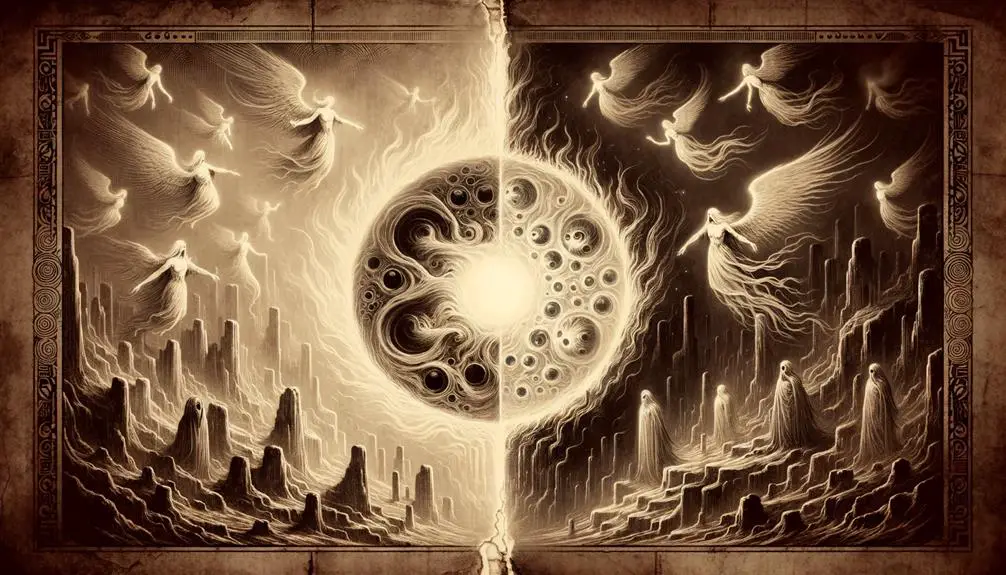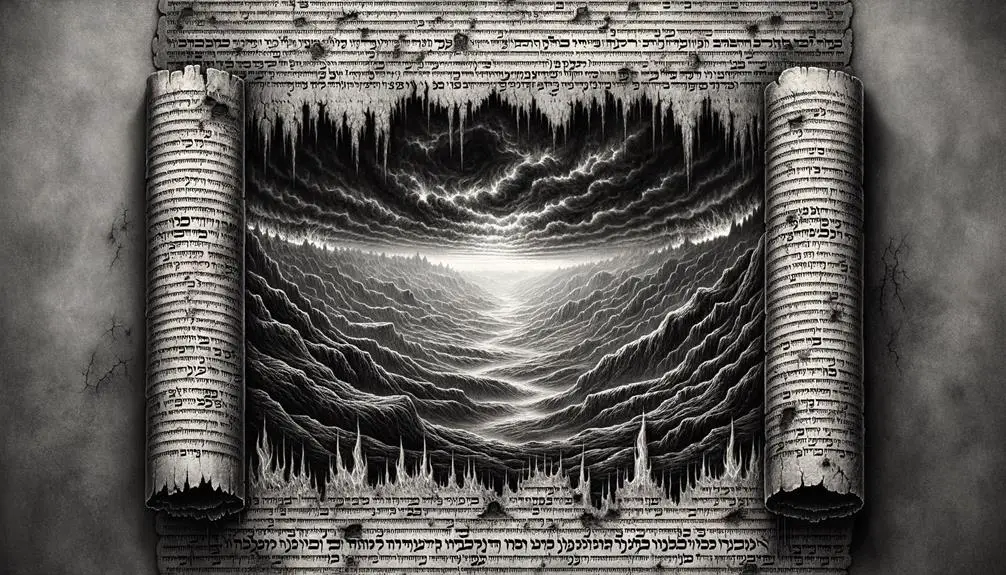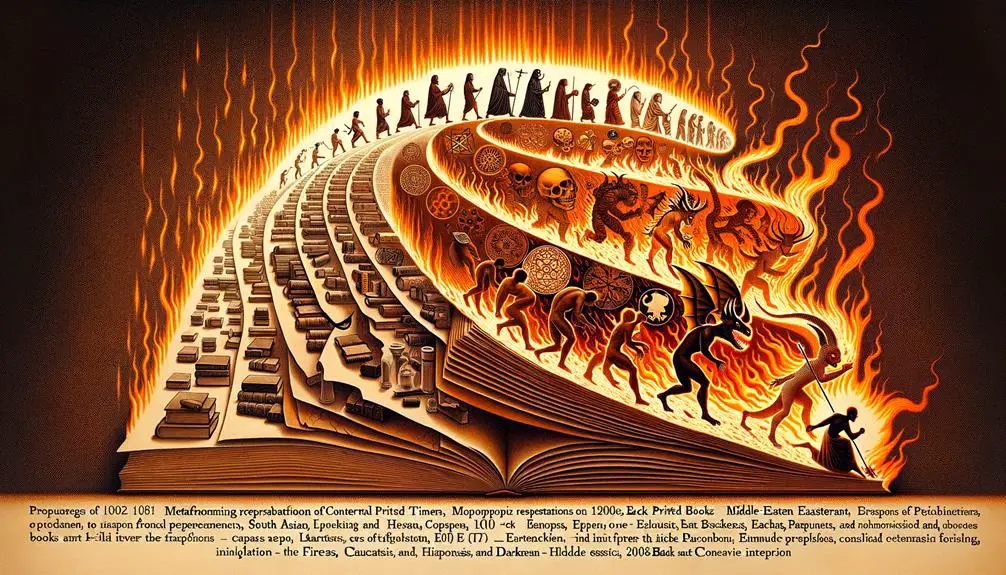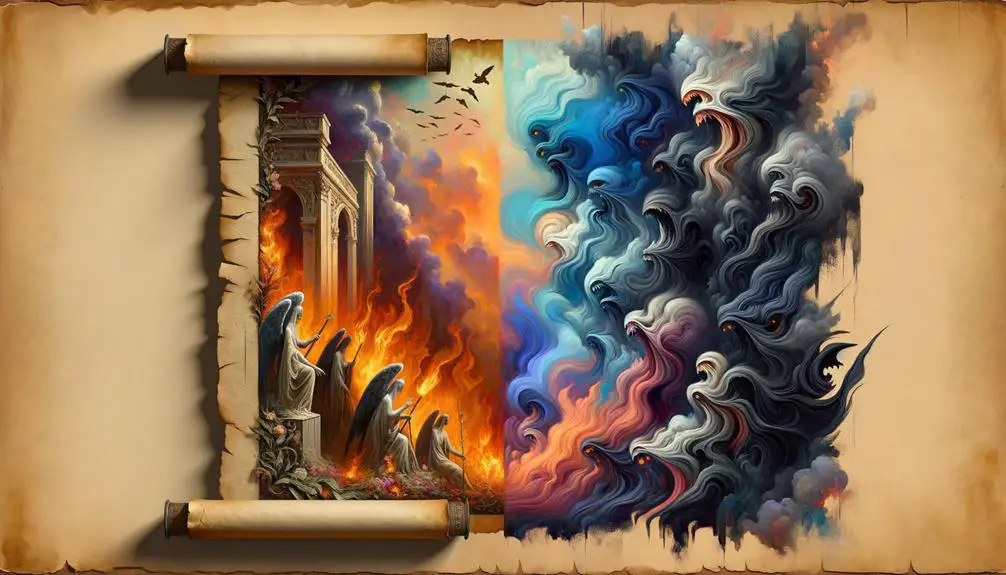When does Hell first emerge in biblical texts? Discover its mysterious origins and the evolution from Sheol to Gehenna.

When Is Hell First Mentioned in the Bible
You'd think the Bible would have opened with something as fiery as Hell, but alas, its editors had other plans. Hell's first biblical cameo isn't as straightforward as you might imagine; it's wrapped in metaphors and ancient languages, evolving from Sheol in the Old Testament to Gehenna in the New.
This journey from the shadowy concept of Sheol to the fiery pits of Gehenna is not just a linguistic evolution but a fascinating reflection of changing theological perspectives. So, why not embark on this intriguing exploration to uncover how and when Hell first made its biblical debut?
Key Takeaways
- Sheol, the ancient underworld, is first introduced in Genesis among other Hebrew scriptures.
- The concept of Hell evolves from Sheol to Gehenna, reflecting judgment.
- New Testament elaborates Hell's imagery, notably in the Parable of Lazarus and Revelation.
- Gehenna becomes symbolic of God's judgment and eternal damnation for the wicked.
The Concept of Sheol

In exploring the biblical origins of concepts related to the afterlife, it's essential to examine Sheol, often considered the earliest notion akin to Hell in the scriptures. Sheol represents an ancient underworld, a shadowy place where the dead reside, irrespective of their moral conduct in life. This concept starkly contrasts with later interpretations of Hell as a place of punishment for the wicked.
Delving into Sheol's etymology and scriptural references, you'll find it deeply rooted in ancient Near Eastern beliefs. Cultural comparisons reveal that Sheol parallels with other ancient underworlds, such as the Greek Hades or the Mesopotamian Aralu. These cultures envisioned the afterlife as a neutral, dusky realm where the dead lead a shadowy existence, devoid of the pleasures and pains of earthly life. This universality underscores a shared ancient perception of the afterlife as a continuation of existence in a diminished form, rather than a place for divine retribution.
Analyzing Sheol within this broader ancient context, it's clear that the Hebrew conception of the afterlife wasn't isolated but part of a larger tapestry of beliefs. The depiction of Sheol as an all-encompassing resting place for the dead, without distinction between the righteous and the wicked, aligns with a wider ancient worldview that viewed death as the great equalizer.
Early References in the Old Testament
Exploring the Old Testament, one finds that references to Sheol, the ancient conception of the afterlife, emerge as early as the book of Genesis, indicating a foundational understanding of the afterlife within Hebrew scripture. This early mention underscores the integral role that afterlife beliefs, specifically the concept of Sheol, play in Hebrew cosmology. Sheol, as described, isn't a place of punishment or reward but rather a shadowy existence, where all the dead go, regardless of their moral conduct in life.
Your exploration into these references reveals a complex and nuanced view of the afterlife that evolves throughout the Old Testament texts. These passages don't just mention Sheol in passing; they weave it into the very fabric of early Hebrew understanding of life, death, and the divine.
Book of the Bible |
Reference to Sheol |
|---|---|
Genesis |
Genesis 37:35 |
Numbers |
Numbers 16:30-33 |
1 Samuel |
1 Samuel 2:6 |
Job |
Job 7:9 |
This table highlights just a few instances where Sheol is explicitly mentioned, demonstrating its pervasive presence in the scriptures. These references, among others, provide a glimpse into the Hebrew afterlife beliefs, illustrating a departure from the concept of a binary heaven-hell afterlife to a more unified and neutral afterlife destination. It's through these scriptural passages that one can begin to understand the ancient Hebrews' view of life after death, which significantly differs from later interpretations and teachings about Hell.
The Transition to Gehenna

The concept of Gehenna marks a significant evolution in Hebrew eschatology, shifting from the neutral afterlife of Sheol to a place of judgment and potential punishment. Gehenna's origins are deeply rooted in the geography and history of the ancient Near East. Originally referring to the Valley of Hinnom, a site near Jerusalem associated with pagan rituals and child sacrifices, Gehenna evolved into a metaphor for divine judgment and retribution. This transition reflects a complex interplay of cultural influences and theological development within the Jewish community.
As you delve deeper into the evolution of Gehenna, it's clear that external cultural influences, especially interactions with Persian and Hellenistic beliefs during and after the Babylonian exile, played a crucial role. These contacts introduced the Jews to concepts of judgment after death, which gradually permeated Jewish thought, leading to a more pronounced dichotomy between reward and punishment in the afterlife.
This shift towards a more punitive conception of the afterlife didn't happen overnight. It was a gradual process, reflected in the changing attitudes towards righteousness, sin, and divine justice. Gehenna became a symbol of God's ultimate judgment, where the wicked would face consequences for their actions, contrasting with the earlier, more uniform concept of Sheol.
New Testament Revelations
As we examine the New Testament, it becomes evident that the concept of Hell undergoes further evolution, reflecting a more defined understanding of afterlife consequences. The imagery and narratives surrounding Hell expand, incorporating both apocalyptic imagery and themes of divine justice. This evolution is pivotal in understanding the broader theological implications of Hell in Christian doctrine.
Several key aspects highlight this evolved understanding:
- Apocalyptic Imagery: The New Testament introduces more vivid, detailed descriptions of Hell. These descriptions often employ apocalyptic imagery to convey the horror and finality of divine judgment. This imagery serves not only to warn but to underline the seriousness of moral choices in one's life.
- Divine Justice: Hell is portrayed as a manifestation of divine justice. It's a place where the wicked receive punishment commensurate with their sins. This concept reinforces the moral order underpinning the universe, as perceived by New Testament authors.
- Eternal Separation: Unlike earlier concepts, the New Testament emphasizes Hell as a state of eternal separation from God. This separation is the ultimate consequence for those who reject divine grace and live in opposition to God's will.
- Universal Accountability: There's a clear message that everyone is accountable before God. Hell underscores the impartiality of divine justice, holding all individuals to the same standards, regardless of their earthly status.
- Moral Urgency: The New Testament teachings on Hell convey a sense of urgency regarding moral and spiritual decisions. This urgency reflects the belief in imminent divine judgment and the eternal stakes involved.
Through these elements, the New Testament revelations on Hell provide a deeper, more nuanced understanding of its role in the Christian eschatological framework.
The Parable of Lazarus

Frequently cited in discussions about Hell's depiction in the New Testament, the Parable of Lazarus vividly illustrates the consequences of moral choices and the realities of the afterlife. You'll find that this parable, unlike any other biblical narrative, directly confronts the afterlife's dichotomy through the lens of a rich man and a poor man named Lazarus. The rich man's fate, as depicted, serves as a profound cautionary tale about the perils of ignoring the plight of those less fortunate.
In this narrative, the rich man, despite his earthly wealth, finds himself in torment after death, symbolizing the ultimate consequence of living a life devoid of compassion and charity. Lazarus, on the other hand, is comforted in the bosom of Abraham, illustrating the reward for a life of suffering endured with patience and faith. The stark contrast between their fates in the afterlife not only underscores the importance of charity but also the belief in a just cosmic order that rectifies the injustices of the earthly life.
Moreover, the dialogue between Abraham and the rich man further cements the parable's lessons on charity. Abraham's refusal to send Lazarus to warn the rich man's still-living brothers emphasizes the sufficiency of Moses and the prophets' teachings on charity and righteousness. This interaction highlights the necessity of heeding spiritual truths and the teachings of scripture as a guide for moral conduct.
Through the Parable of Lazarus, you're invited to reflect on the deep-seated implications of your actions and the inherent value of compassion and charity in shaping one's ultimate destiny.
Hell in the Book of Revelation
You'll find that the Book of Revelation offers a complex and vivid depiction of hell, markedly distinct from earlier biblical references.
It introduces the concept of the Lake of Fire, a symbol rich in theological and eschatological significance.
This imagery not only serves as a culmination of biblical warnings about afterlife punishment but also encapsulates the ultimate fate of sin according to Christian doctrine.
Revelation's Hell Descriptions
In the Book of Revelation, vivid and harrowing descriptions of Hell are presented, revealing a place of eternal torment for the wicked. These passages are rife with apocalyptic imagery, emphasizing the dire fate awaiting those who stray from the path of righteousness.
- Infernal beasts symbolize the ultimate punishment and chaos.
- Darkness and fire are recurrent motifs, illustrating Hell's despair.
- The unending nature of suffering underscores the permanence of divine judgment.
- Sounds of wailing and gnashing of teeth evoke the anguish of the damned.
- The absence of hope or redemption highlights the finality of Hell's judgment.
Through these elements, Revelation paints a daunting picture of Hell, reinforcing the consequences of moral and spiritual failure.
Lake of Fire Symbolism
Among the most potent symbols found in the Book of Revelation, the Lake of Fire stands as a stark representation of eternal damnation for the wicked. This imagery isn't just a narrative choice; it's a theological statement, steeped in fire symbolism that's been prevalent throughout biblical texts.
Fire, often associated with purification and divine wrath, here underscores the finality and severity of eternal punishment. Analyzing this, you'll find that the Lake of Fire isn't merely a physical locale but a symbol of ultimate spiritual demise. The text meticulously portrays it as the culmination of divine justice, a deterrent and reminder of the consequences of turning away from the path of righteousness.
Its inclusion serves as a critical anchor for the book's overarching theme of salvation and judgment.
Interpretations Over Centuries

As you explore the evolution of the concept of Hell, you'll find that interpretations have shifted dramatically from the early Christian views through to the vivid depictions of the medieval period, and into the nuanced understandings of the modern era.
These shifts reflect broader changes in theological, philosophical, and cultural perspectives across centuries. Each phase, from the initial formation of Hell's concept to contemporary interpretations, reveals the complex interplay between scripture, societal values, and human fears.
Early Christian Views
Over centuries, early Christians developed various interpretations of Hell, reflecting diverse theological perspectives within the faith. This variation stemmed from several sources:
- Gnostic interpretations offered an esoteric view of Hell, emphasizing a spiritual rather than physical torment.
- Apocryphal texts contributed to a rich tapestry of beliefs regarding the afterlife, often diverging from canonical scripture.
- Early church fathers debated the nature of Hell, leading to differing doctrines on its permanence and purpose.
- The concept of purgatorial fires emerged, suggesting a temporary, purifying process.
- Scriptural exegesis varied widely, with some focusing on the metaphorical meanings behind biblical references to Hell.
These early views set the stage for evolving understandings of Hell within Christianity, highlighting the faith's complex theological landscape.
Medieval Hell Depictions
During the Medieval period, depictions of Hell evolved significantly, reflecting broader changes in theological thought and cultural practices. Gothic architecture, with its towering spires and detailed sculptures, often portrayed the torments of Hell, serving as a visual reminder of the consequences of sin. These architectural marvels weren't just structures but sermons in stone, embodying the era's deep-seated beliefs about the afterlife.
Meanwhile, Dante's Inferno, a masterpiece of literature, offered a vivid, detailed journey through Hell's nine circles. Dante's work, infused with allegory and moral lessons, became a cornerstone of Medieval thought, influencing not just theological discourse but also how society visualized Hell. His descriptions intertwined with Gothic art, painting a comprehensive picture of Hell that would endure for centuries.
Modern Interpretations Shift
While the Medieval period solidified the imagery of Hell with its gothic spires and Dante's allegorical journey, subsequent centuries witnessed a profound evolution in the interpretation of this infernal realm.
- Cultural influences began reshaping Hell's perception, integrating elements from folklore and local beliefs.
- Philosophical debates questioned the nature of damnation and redemption, influencing theological perspectives.
- The rise of secularism subtly shifted Hell from a literal place to a metaphorical state of being in some interpretations.
- Literary contributions continued to evolve Hell's imagery, reflecting society's changing fears and moral concerns.
- Scientific advancements contributed to a more symbolic understanding of Hell, emphasizing psychological and existential interpretations over physical torment.
This evolution demonstrates Hell's adaptability, mirroring humanity's complex relationship with the concept of ultimate justice and punishment.
Modern Understandings of Hell

Contemporary interpretations of Hell diverge significantly, reflecting a spectrum of theological, philosophical, and cultural perspectives on its existence and nature. You'll find that cultural variations play a pivotal role in shaping these modern understandings.
In some cultures, Hell is viewed through a traditional religious lens, depicted as a place of eternal punishment for the wicked. In others, it's seen more metaphorically, representing personal or communal struggles rather than a literal afterlife destination. This divergence not only highlights the multiplicity of beliefs about Hell but also emphasizes the psychological impacts these views have on individuals and societies.
The fear of Hell, for instance, can lead to profound existential anxiety or motivate moral behavior, depending on one's belief system and the cultural context in which these beliefs are held.
Moreover, in the scholarly realm, there's a growing interest in examining Hell not just as a religious construct but as a psychological and cultural phenomenon. Researchers delve into how beliefs about Hell influence human behavior, societal norms, and even politics. This analytical approach seeks to understand Hell's enduring presence in human consciousness and its adaptability across different epochs and societies.
Frequently Asked Questions
How Do Different Religious Traditions Outside of Christianity Interpret the Concept of Hell?
You'll find that in Islamic eschatology, hell is depicted as a place of eternal punishment for the wicked. It's detailed, with vivid descriptions of its torments.
Meanwhile, Hinduism's afterlife views are more varied, with concepts of hell serving as temporary realms for purification rather than eternal damnation.
Both traditions offer a rich tapestry of beliefs that diverge from each other and from Christian interpretations, showcasing a complex understanding of the afterlife.
Are There Any Notable Figures or Saints Who Claimed to Have Visions of Hell, and How Did Those Visions Influence Religious Teachings?
You're delving into the realm where visions of hell, painted by notable figures, have shaped beliefs. Visionary authenticity, paired with historical impact, underscores these experiences' influence on religious teachings.
Saints like Teresa of Ávila and John Bosco shared profound encounters, their vivid descriptions weaving through the fabric of faith. Analyzing these accounts, you're not just tracing narratives; you're exploring how these divine insights have etched themselves into the collective spiritual consciousness.
How Do Contemporary Theologians Reconcile the Existence of Hell With the Concept of a Loving and Merciful God?
You're tackling how theologians mesh the existence of hell with a loving God. They argue divine justice and free will are key. Essentially, God's love offers freedom, including the choice to reject Him.
Hell, then, isn't a contradiction but a consequence of free will, underscoring divine justice. This perspective maintains God's mercy while respecting human autonomy, providing a nuanced understanding of these seemingly conflicting concepts within theological discussions.
In What Ways Has the Imagery and Understanding of Hell Influenced Modern Popular Culture, Such as in Literature, Film, and Art?
Hell's imagery has deeply influenced modern culture, particularly in literature, film, and art.
You've seen its impact in hell-themed video games and horror movie tropes, where the concept of eternal damnation fuels narratives of fear and moral lessons.
This portrayal not only entertains but also prompts reflection on morality and the afterlife.
It's fascinating how these depictions blend ancient religious concepts with contemporary entertainment, shaping your understanding of hell and its consequences.
How Does the Concept of Hell in the Bible Compare to the Underworlds Mentioned in Other Ancient Texts and Mythologies?
You're exploring how the Bible's depiction of hell compares to underworlds in various ancient texts, focusing on ancient parallels and mythological influences.
This approach reveals that while the concept of a punitive afterlife is a common thread, the vivid descriptions and functions of these realms vary significantly.
Ancient mythologies often presented more nuanced realms of the afterlife, where punishments and rewards were meted out based on moral and heroic deeds, rather than a binary heaven or hell.
Conclusion
You've navigated the complex terrain of hell's biblical origins, from Sheol's shadowy depths to Gehenna's fiery despair, and pierced through New Testament revelations.
The evolution of hell, from a place of mere existence to eternal damnation, showcases the Bible's layered interpretations. Grappling with this concept isn't just splitting hairs; it's a vital exploration of faith, morality, and the afterlife's mysteries.
Modern understandings continue to evolve, reflecting our endless quest to decipher the divine narrative woven into the fabric of ancient texts.



Sign up